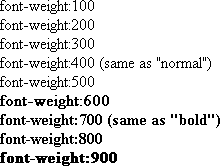Font Weight
font-weight indicates how bold the characters should be.
font-weight can be assigned a multiple of 100 from 100 to 900 (900 being the boldest). So, for example, this rule (in a
STYLE tag or in a
style sheet file) says that
<H2 ...> elements should have a weight of 900:
H2 {font-weight:900}
which means that an <H2 ...> element is rendered like this:
Weighty Matters
You can also use the words "normal" (the same as 400), "bold" (same as 700), "bolder" (a relative statement meaning to make the text bolder than the surrounding element), or "lighter" (make the text lighter than the surrounding element). Because few fonts have nine shades of boldness, in most fonts 100 to 500 are the same, 600 to 800 are the same, and 900 is boldest. One of the ramifications of this is that although "normal" is 400, 100 is not really any lighter. There is no practical way to present text with less-than-normal weight.

Renderings of different font weights
